Spatial Assessment of Degraded Lands for Biofuel Production in Indonesia
Abstract
:1. Introduction
2. Species and Land for Biofuel Production in Indonesia
2.1. Potential Biofuel Species in Indonesia
2.2. Lands Available for Producing Biomass in Indonesia
3. Materials and Methods
3.1. Identification of Degraded Lands in Indonesia
3.2. Suitability of Degraded Lands to Grow Biofuel Species
Mscore = MSaltitude + MSrainfall + MStempt + MSsoil slope + MSsoil pH + MSsoil depth
4. Results
4.1. Degraded Lands in Indonesia
4.2. Suitability of Degraded Lands to Grow Biofuel Species
4.3. Hypothetical Maximum Energy Productivity
5. Discussion
6. Conclusions
Author Contributions
Funding
Acknowledgments
Conflicts of Interest
References
- Lewis, S.; Kelly, M. Mapping the potential for biofuel production on marginal lands: Differences in definitions, data and models across scales. ISPRS Int. J. Geo-Inf. 2014, 3, 430–459. [Google Scholar] [CrossRef]
- IRENA (International Renewable Energy Agency). Renewable Energy Prospects: Indonesia, a REmap Analysis; International Renewable Energy Agency: Abu Dhabi, UAE, 2017. [Google Scholar]
- GAIN (Global Agriculture Information Network). Indonesia Biofuels Annual 2017; USDA Foreign Agricultural Service: Jakarta, Indonesia, 2017.
- DEN (Dewan Energi National). Indonesia Energy Outlook 2016; Dewan Energi National: Jakarta, Indonesia, 2017.
- ICCC (Indonesia Climate Change Center). Crops to Energy on Degraded Land as a Step toward Energy Independence, Carbon Sink Agriculture and Protection of REDD+ Designated Areas; Indonesia Climate Change Center: Jakarta, Indonesia, 2014. [Google Scholar]
- Wulandari, W.S.; Darusman, D.; Cecep Kusmana, W. Land suitability analysis of biodiesel crop Kemiri Sunan (Reutealis trisperma (Blanco) Airy Shaw) in the Province of West Java, Indonesia. J. Environ. Earth Sci. 2014, 4, 27–37. [Google Scholar]
- Baral, H.; Lee, S.M. Sustainable Bioenergy Systems to Restore and Valorize Degraded Land; Center for International Forestry Research: Bogor, Indonesia, 2016. [Google Scholar]
- Borchard, N.; Artati, Y.; Lee, S.M.; Baral, H. Sustainable Forest Management for Land Rehabilitation and Provision of Biomass-Energy; Center for International Forestry Research: Bogor, Indonesia, 2017. [Google Scholar]
- Harahap, F.; Silveira, S.; Khatiwada, D. Land allocation to meet sectoral goals in Indonesia—An analysis of policy coherence. Land Use Policy 2017, 61, 451–465. [Google Scholar] [CrossRef]
- Fargione, J.; Hill, J.; Tilman, D.; Polasky, S. Land clearing and the biofuel carbon debt. Science 2008, 319, 1235–1238. [Google Scholar] [CrossRef] [PubMed]
- Goh, C.S.; Wicke, B.; Potter, L.; Faaij, A.; Zoomers, A.; Junginger, M. Exploring under-utilised low carbon land resources from multiple perspectives: Case studies on regencies in Kalimantan. Land Use Policy 2017, 60, 150–168. [Google Scholar] [CrossRef]
- Danielsen, F.; Beukema, H.; Burgess, N.; Parish, F.; Brühl, C.; Donald, P.; Murdiyarso, D.; Phalan, B.; Reijnders, L.; Struebig, M.; et al. Biofuel plantations on forested lands: Double jeopardy for biodiversity and climate. Conserv. Biol. 2009, 23, 348–358. [Google Scholar] [CrossRef]
- Bryan, B.A.; Ward, J.; Hobbs, T. An assessment of the economic and environmental potential of biomass production in an agricultural region. Land Use Policy 2008, 25, 533–549. [Google Scholar] [CrossRef]
- Richardson, D.M.; Blanchard, R. Learning from our mistakes: Minimizing problems with invasive biofuel plants. Curr. Opin. Environ. Sustain. 2011, 3, 36–42. [Google Scholar] [CrossRef]
- Maraseni, T.N.; Cockfield, G. The financial implications of converting farmland to state-supported environmental plantings in the Darling Downs region, Queensland. Agric. Syst. 2015, 135, 57–65. [Google Scholar] [CrossRef]
- Scott, P.T.; Pregelj, L.; Chen, N.; Hadler, J.S.; Djordjevic, M.A.; Gresshoff, P.M. Pongamia pinnata: An untapped resource for the biofuels industry of the future. Bioenergy Res. 2008, 1, 2–11. [Google Scholar] [CrossRef]
- Ong, H.; Mahlia, T.; Masjuki, H.; Norhasyima, R. Comparison of palm oil, Jatropha curcas and Calophyllum inophyllum for biodiesel: A review. Renew. Sustain. Energy Rev. 2011, 15, 3501–3515. [Google Scholar] [CrossRef]
- Syamsuwida, D.; Kurniaty, R.; Putri, K.P.; Suita, E. Kaliandra (Calliandra callothyrsus) as a timber for energy: In a point of view of seeds and seedlings procurement. Energy Procedia 2014, 47, 62–70. [Google Scholar] [CrossRef]
- Fadhlullah, M.; Widiyanto, S.N.B.; Restiawaty, E. The potential of nyamplung (Calophyllum inophyllum L.) seed oil as biodiesel feedstock: Effect of seed moisture content and particle size on oil yield. Energy Procedia 2015, 68, 177–185. [Google Scholar] [CrossRef]
- Leksono, B.; Windyadni, E.; Hasnah, T.M. Growth, flowering, fruiting and biofuel content of Calopyllum inophyllum in provenance seed stand. In Proceedings of the International Conference of Indonesia Forestry Researchers III-2015, Bogor, Indonesia, 21–22 October 2015. [Google Scholar]
- Hambali, E.; Nisya, F.N.; Thahar, A.; Nuryanti, A.; Wijaya, H. Potential of biomass as bioenergy feedstock in Indonesia. J. Jpn. Inst. Energy 2016, 95, 629–638. [Google Scholar] [CrossRef]
- Bustomi, S.; Rostiwati, T.; Sudradjat, R.; Kosasih, A.S.; Anggraeni, I.; Leksono, B.; Irawanti, S.; Kurniaty, R.; Syamsuwida, D.; Effendi, R.; et al. Nyamplung (Calophyllum inophyllum L.) Sumber Energi Biofuel Yang Potensial; Kementerian Kehutanan: Jakarta, Indonesia, 2008.
- Chandra, B.B.; Setiawan, F.; Gunawan, S.; Widjaja, T. Pemanfaatan Biji Buah Nyamplung (Callophylum Inophylum) Sebagai Bahan Baku Pembuatan Biodisel. Jurnal Teknik ITS 2013, 2, B13–B15. [Google Scholar]
- Leksono, B.; Windyarini, E.; Hasnah, T.M. Budidaya Tanaman Nyamplung (Calophyllum inophyllum) untuk Bioenergi dan Prospek Pemanfaatan Lainnya; IPB Press: Jakarta, Indonesia, 2014. [Google Scholar]
- Fuwape, J.A.; Akindele, S.O. Biomass yield and energy value of some fast-growing multipurpose trees in Nigeria. Biomass Bioenergy 1997, 12, 101–106. [Google Scholar] [CrossRef]
- Herman, M.; Syakir, M.; Pranowo, D.; Saefudin, S. Kemiri Sunan (Reutealis trisperma (Blanco) Airy Shaw) Tanaman Penghasil Minyak Nabati dan Konservasi Lahan; IAARD Press: Jakarta, Indonesia, 2013. [Google Scholar]
- Orwa, C.; Mutua, A.; Kindt, R.; Jamnadass, R.; Anthony, S. Agroforestree Database: A Tree Reference and Selection Guide Version 4.0; World Agroforestry Centre: Nairobi, Kenya, 2009. [Google Scholar]
- Riayatsyah, T.M.I.; Ong, H.C.; Chong, W.T.; Aditya, L.; Hermansyah, H.; Mahlia, T.M.I. Life cycle cost and sensitivity analysis of Reutealis trisperma as non-edible feedstock for future biodiesel production. Energies 2017, 10, 877. [Google Scholar] [CrossRef]
- Al Muqarrabun, L.M.R.; Ahmat, N.; Ruzaina, S.A.S.; Ismail, N.H.; Sahidin, I. Medicinal uses, phytochemistry and pharmacology of Pongamia pinnata (L.) Pierre: A review. J. Ethnopharmacol. 2013, 150, 395–420. [Google Scholar] [CrossRef]
- Aminah, A.A.M.; Supriyanto, A.S.; Siregar, I.Z. Genetic diversity of Pongamia pinnata (Millettia pinnata, aka. malapari) populations in Java Island, Indonesia. Biodiversitas 2017, 18, 677–681. [Google Scholar] [CrossRef]
- Aunillah, A.; Pranowo, D. Karakteristik biodiesel kemiri sunan [Reutealis trisperma (Blanco) Airy Shaw] menggunakan proses transesterifikasi dua tahap. Jurnal Tanaman Industri dan Penyegar 2012, 3, 193–200. [Google Scholar]
- Hendra, D. Pembuatan Biodiesel Dari Biji Kemiri Sunan. Jurnal Penelitian Hasil Hutan 2014, 32, 37–45. [Google Scholar]
- Syamsuwida, D.; Putri, K.P.; Kurniaty, R.; Aminah, A. Seeds and seedlings production of bioenergy tree species Malapari (Pongamia pinnata (L.) Pierre). Energy Procedia 2015, 65, 67–75. [Google Scholar] [CrossRef]
- Adaganti, S.Y.; Yaliwal, V.S.; Kulkarni, B.M.; Desai, G.P.; Banapurmath, N.R. Factors affecting bioethanol production from lignocellulosic biomass (Calliandra calothyrsus). Waste Biomass Valorization 2014, 5, 963–971. [Google Scholar] [CrossRef]
- Palmer, B.; Macqueen, D.; Gutteridge, R. 2.4 Calliandra calothyrsus—A multipurpose tree legume for humid locations. In Forage Tree Legumes in Tropical Agriculture; CAB International: Wallingford, UK, 1994; Volume 65. [Google Scholar]
- Amirta, R.; Yuliansyah, A.E.M.; Ananto, B.R.; Setiyono, B.; Haqiqi, M.T.; Septiana, H.A.; Lodong, M.; Oktavianto, R.N. Plant diversity and energy potency of community forest in East Kalimantan, Indonesia: Searching for fast growing wood species for energy production. Nusant. Biosci. 2016, 8, 22–31. [Google Scholar] [CrossRef]
- Atabani, A.; Silitonga, A.; Ong, H.; Mahlia, T.; Masjuki, H.; Badruddin, I.A.; Fayaz, H. Non-edible vegetable oils: A critical evaluation of oil extraction, fatty acid compositions, biodiesel production, characteristics, engine performance and emissions production. Renew. Sustain. Energy Rev. 2013, 18, 211–245. [Google Scholar] [CrossRef]
- Bhattacharya, S.; Salam, P.A.; Pham, H.; Ravindranath, N. Sustainable biomass production for energy in selected Asian countries. Biomass Bioenergy 2003, 25, 471–482. [Google Scholar] [CrossRef]
- Dahlanuddin Yanuarianto, O.; Poppi, D.P.; McLennan, S.R.; Quigley, S.P. Liveweight gain and feed intake of weaned Bali cattle fed grass and tree legumes in West Nusa Tenggara, Indonesia. Anim. Prod. Sci. 2014, 54, 915–921. [Google Scholar] [CrossRef]
- Knothe, G.; de Castro ME, G.; Razon, L.F. Methyl esters (biodiesel) from and fatty acid profile of Gliricidia sepium seed oil. J. Am. Oil Chem. Soc. 2015, 92, 769–775. [Google Scholar] [CrossRef]
- Kumar, K.R.; Chandrika, K.; Prasanna, K.T.; Gowda, B. Biodiesel production and characterization from non-edible oil tree species Aleurites trisperma Blanco. Biomass Convers. Biorefinery 2015, 5, 287–294. [Google Scholar] [CrossRef]
- Yohana, E.; Yulianto, M.E.; Ikhsan, D.; Nanta, A.M.; Puspitasari, R. The development of the super-biodiesel production continuously from Sunan pecan oil through the process of reactive distillation. AIP Conf. Proc. 2016, 1737, 1–10. [Google Scholar]
- Holilah, H.; Prasetyoko, D.; Oetami, T.P.; Santosa, E.B.; Zein, Y.M.; Bahruji, H.; Fansuri, H.; Ediati, R.; Juwari, J. The potential of Reutealis trisperma seed as a new non-edible source for biodiesel production. Biomass Convers. Biorefinery 2015, 5, 347–353. [Google Scholar] [CrossRef]
- Pranowo, D.; Herman, M. Potensi pengembangan kemiri sunan (Reutealis trisperma (Blanco) Airy Shaw) di lahan terdegradasi. Perspektif 2016, 14, 87–101. [Google Scholar] [CrossRef]
- Dwivedi, G.; Sharma, M.P. Prospects of biodiesel from Pongamia in India. Renew. Sustain. Energy Rev. 2014, 32, 114–122. [Google Scholar] [CrossRef]
- Sangwan, S.; Rao, D.V.; Sharma, R.A. A review on Pongamia pinnata (L.) Pierre: A great versatile leguminous plant. Nat. Sci. 2010, 8, 130–139. [Google Scholar]
- Jiang, Q.; Yen, S.-H.; Stiller, J.; Edwards, D.; Scott, P.T.; Gresshoff, P.M. Genetic, biochemical, and morphological diversity of the legume biofuel tree Pongamia pinnata. J. Plant Genome Sci. 2012, 1, 54–67. [Google Scholar] [CrossRef]
- Siregar, N.; Djam’an, D.F. Pengaruh bahan tanaman terhadap keberhasilan setek kranji (Pongamia pinnata). Pros. Semin. Nas. Masy. Biodiversitas Indones. 2017, 3, 23–27. [Google Scholar]
- Wulandari, W.S. Strategi Pengembangan Biodiesel Kemiri Sunan (Reutealis trisperma (Blanco) Airy Shaw) Di Jawa Barat; Institut Pertanian Bogor: Bogor, Indonesia, 2015. [Google Scholar]
- Herdiawan, I.; Sutedi, E. Productivity of Calliandra calothyrsus, Indigofera zollingeriana and Gliricidia sepium on acid soil in the greenhouse. Indones. J. Anim. Vet. Sci. 2015, 20, 105–114. [Google Scholar] [CrossRef]
- Fanish, S.A.; Priya, R.S. Review on benefits of agroforestry system. Int. J. Educ. Res. 2013, 1, 1–12. [Google Scholar]
- Yaliwal, V.S.; Adaganti, S.Y.; Kulkarni, B.M.; Desai, G.P. Production of renewable and sustainable fuel from Calliandra calothyrsus and its utilisation in compression ignition engines. Int. J. Sustain. Eng. 2014, 7, 41–54. [Google Scholar] [CrossRef]
- Lim, T.K. Gliricidia sepium. In Edible Medicinal and Non-Medicinal Plants; Lim, T.K., Ed.; Springer: Dordrecht, The Netherlands, 2014; Volume 7, pp. 806–816. [Google Scholar]
- Colchester, M.; Jiwan, N.; Andiko, M.S.; Firdaus, A.Y.; Surambo, A.; Pane, H. Promised Land: Palm Oil and Land Acquisition in Indonesia-Implications for Local Communities and Indigenous Peoples: Moreton-In-Marsh, Forest Peoples Programme; Perkumpulan Sawit Watch, HuMA and the World Agroforestry Centre: Moreton-in-Marsh, UK; Bogor, Indonesia, 2006. [Google Scholar]
- Gingold, B.; Rosenbarger, A.; Muliastra, Y.; Stolle, F.; Sudana, I.M.; Manessa, M.D.M.; Murdimanto, A.; Tiangga, S.B.; Madusari, C.C.; Douard, P.; et al. How to Identify Degraded Land for Sustainable Palm Oil in Indonesia; World Resources Institute: Washington, DC, USA, 2012. [Google Scholar]
- Milbrandt, A.; Overend, R.P. Assessment of Biomass Resources from Marginal Lands in APEC Economies; National Renewable Energy Laboratory (NREL): Golden, CO, USA, 2009.
- Nijsen, M.; Smeets, E.; Stehfest, E.; Vuuren, D.P. An evaluation of the global potential of bioenergy production on degraded lands. GCB Bioenergy 2012, 4, 130–147. [Google Scholar] [CrossRef]
- DPEPDA (Direktorat Perencanaan dan Evaluasi Pengendalian Daerah Aliran Sungai). Peta Digital Lahan Kritis Tahun 2011; Sub Direktorat Pemolaan Pengelola Daerah Aliran Sungai: Jakarta, Indonesia, 2015. [Google Scholar]
- DPPKH (Direktorat Pengukuhan dan Penatagunaan Kawasan Hutan). Peta Digital Kawasan Hutan Tahun 2014; Sub Direktorat Pengukuhan Kawasan Hutan Wilayah I dan II: Jakarta, Indonesia, 2015. [Google Scholar]
- DIPSH (Direktorat Inventarisasi dan Pemantauan Sumberdaya Hutan). Peta Digital Penutupan Lahan Tahun 2014; Sub Direktorat Pemantauan Sumberdaya Hutan: Jakarta, Indonesia, 2015. [Google Scholar]
- MoF (Ministry of Forestry of Indonesia). Pembakuan Standar Penafsiran Citra Satelit Resolusi Sedang. Badan Planologi Kehutanan Departemen Kehutanan dan Badan Informasi Geospasial (BIG); Ministry of Forestry of Indonesia: Jakarta, Indonesia, 2003.
- RePPProT (Regional Physical Planning Program for Transmigration). The Land Resources of Indonesia: A National Overview. Government of Republic of Indonesia: Ministry of Transmigration, Directorate General of Settlement Preparation, and BAKOSURTANAL; Land Resources Department, Natural Resources Institute, Overseas Development Administration, Foreign and Commonwealth Office: London, UK, 1990. [Google Scholar]
- FAO (Food and Agriculture Organization of the United Nations). 2007. Available online: http://ecocrop.fao.org/ecocrop/srv/en/cropSearchForm (accessed on 27 July 2017).
- CABI. Reutealis trisperma (Philippine tung). 2018. Available online: https://www.cabi.org/isc/datasheet/4125 (accessed on 4 December 2018).
- Miyake, S.; Smith, C.; Peterson, A.; McAlpine, C.; Renouf, M.; Waters, D. Environmental implications of using ‘underutilised agricultural land’ for future bioenergy crop production. Agric. Syst. 2015, 139, 180–195. [Google Scholar] [CrossRef]
- National Academy Press. Ad Hoc Pallel of the Advisory Committee on Technology Innovation Board on Science and Technology for International Development Office of International Affairs National Research Council. Innovations in Tropical Reforestation: Calliandra A Versatile Small Tree for the Humid Tropics; National Academy Press: Washington, DC, USA, 1983. [Google Scholar]
- Stewart, J.L.; Allison, G.E.; Simons, A.J. Gliricidia Sepium: Genetic Resources for Farmers; Oxford Forestry Institute, University of Oxford: Oxford, UK, 1996. [Google Scholar]
- Lee, J.S.H.; Abood, S.; Ghazoul, J.; Barus, B.; Obidzinski, K.; Koh, L.P. Environmental impacts of large-scale oil palm enterprises exceed that of smallholdings in Indonesia. Conserv. Lett. 2014, 7, 25–33. [Google Scholar] [CrossRef]
- Mohibbe Azam, M.; Waris, A.; Nahar, N.M. Prospects and potential of fatty acid methyl esters of some non-traditional seed oils for use as biodiesel in India. Biomass Bioenergy 2005, 29, 293–302. [Google Scholar] [CrossRef]
- Ong, H.C.; Masjuki, H.H.; Mahlia, T.M.I.; Silitonga, A.S.; Chong, W.T.; Yusaf, T. Engine performance and emissions using Jatropha curcas, Ceiba pentandra and Calophyllum inophyllum biodiesel in a CI diesel engine. Energy 2014, 69, 427–445. [Google Scholar] [CrossRef]
- Kumar, A.; Sharma, S. Potential non-edible oil resources as biodiesel feedstock: An Indian perspective. Renew. Sustain. Energy Rev. 2011, 15, 1791–1800. [Google Scholar] [CrossRef]
- Atabani, A.E.; César, A.D.S. Calophyllum inophyllum L.—A prospective non-edible biodiesel feedstock. Study of biodiesel production, properties, fatty acid composition, blending and engine performance. Renew. Sustain. Energy Rev. 2014, 37, 644–655. [Google Scholar] [CrossRef]
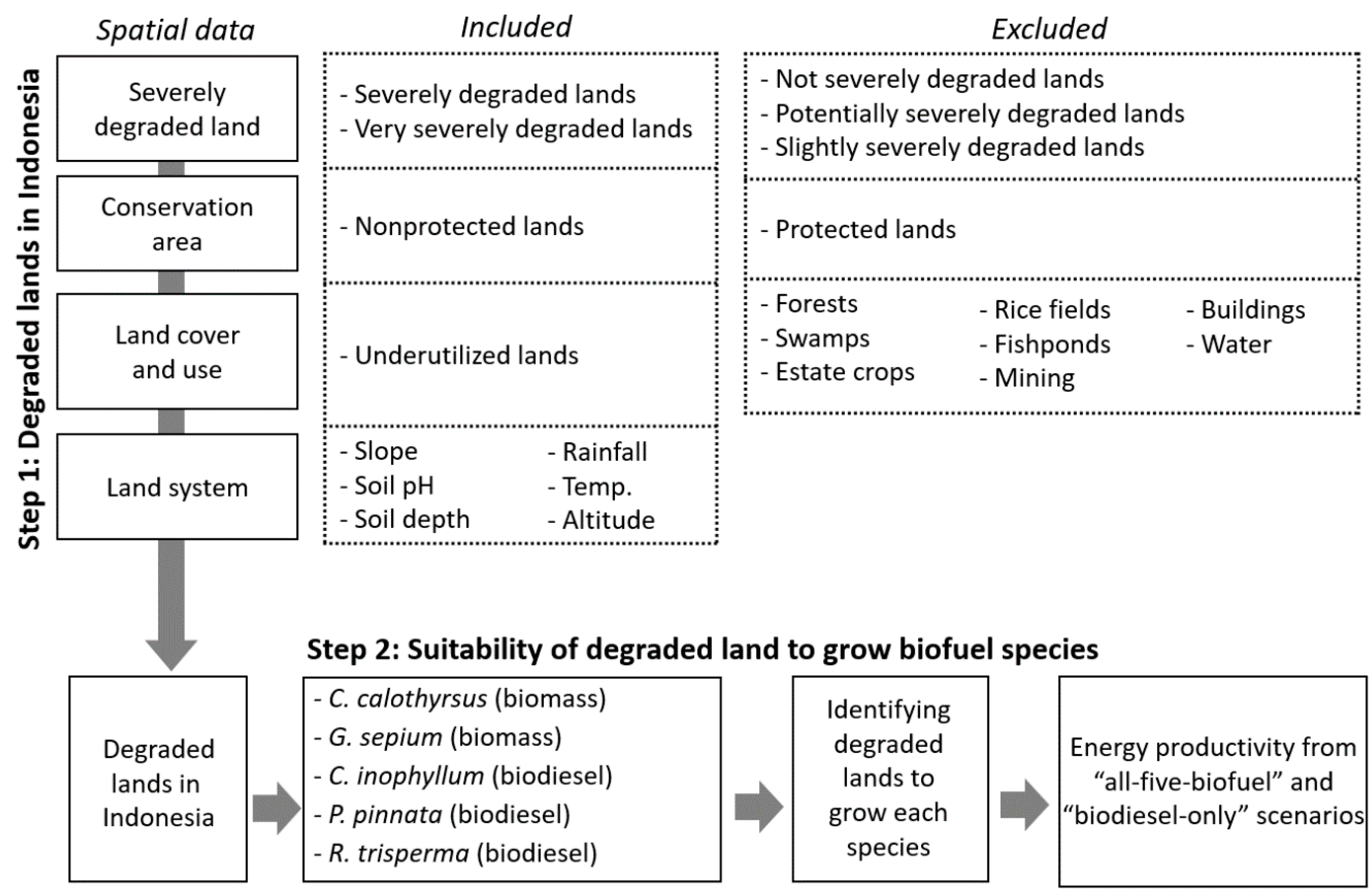
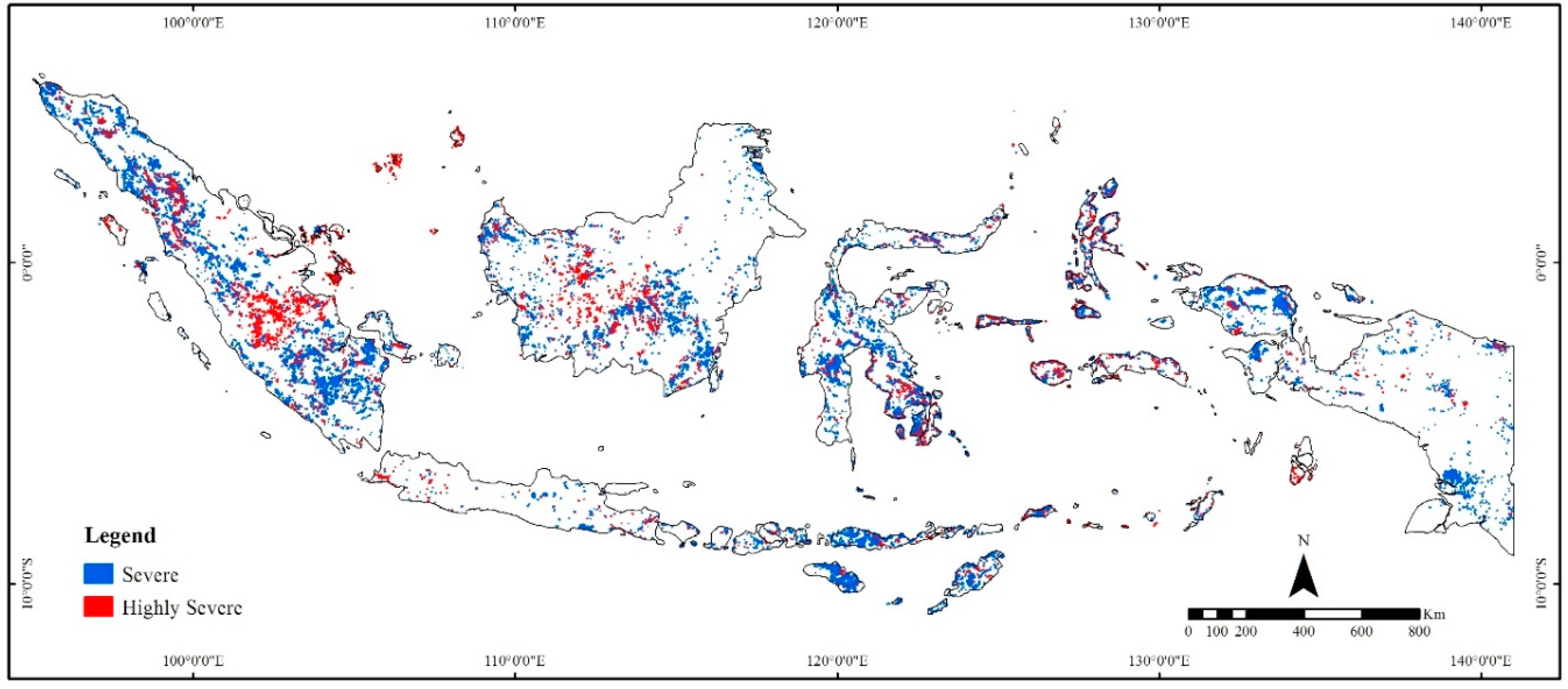
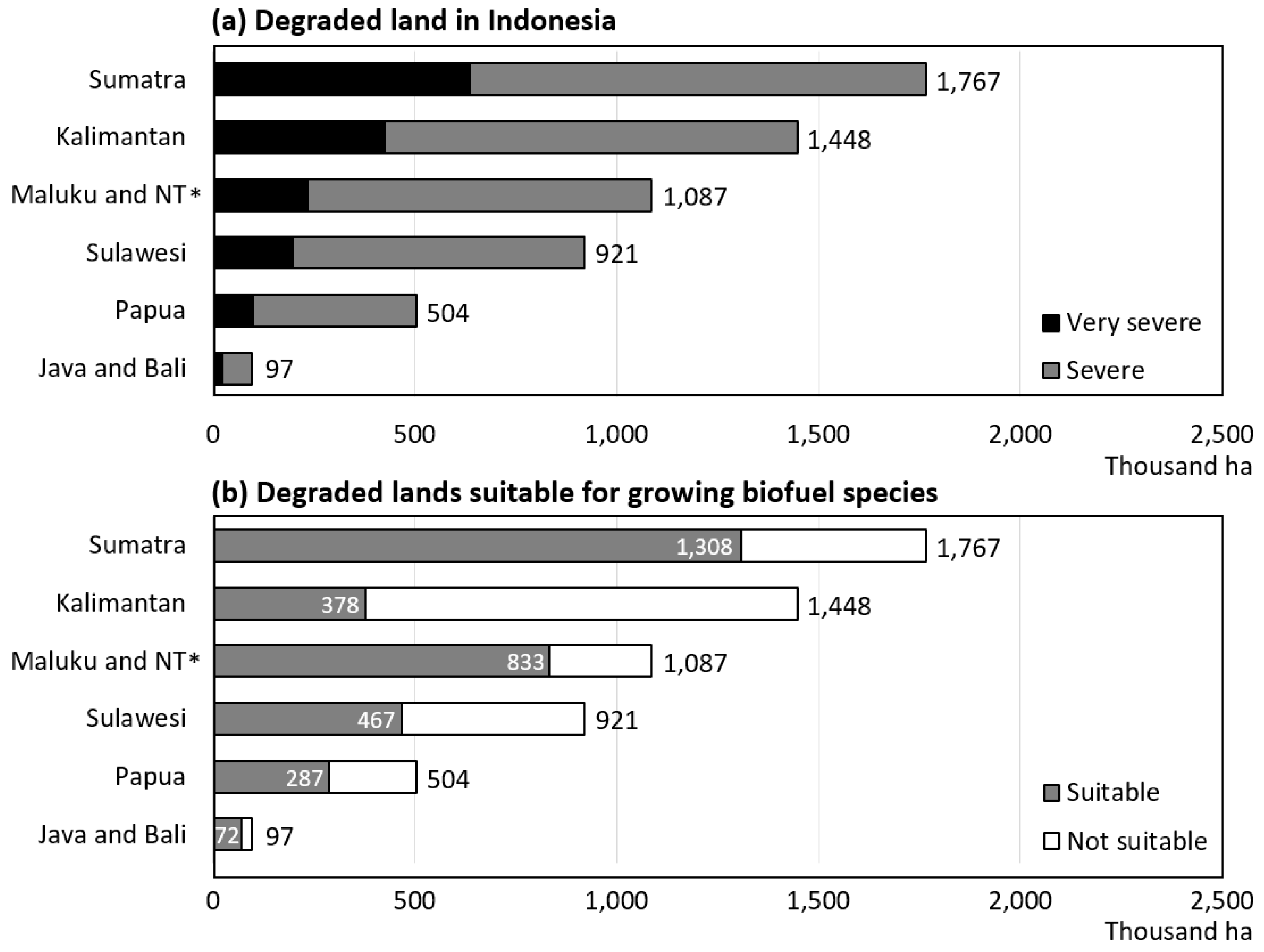
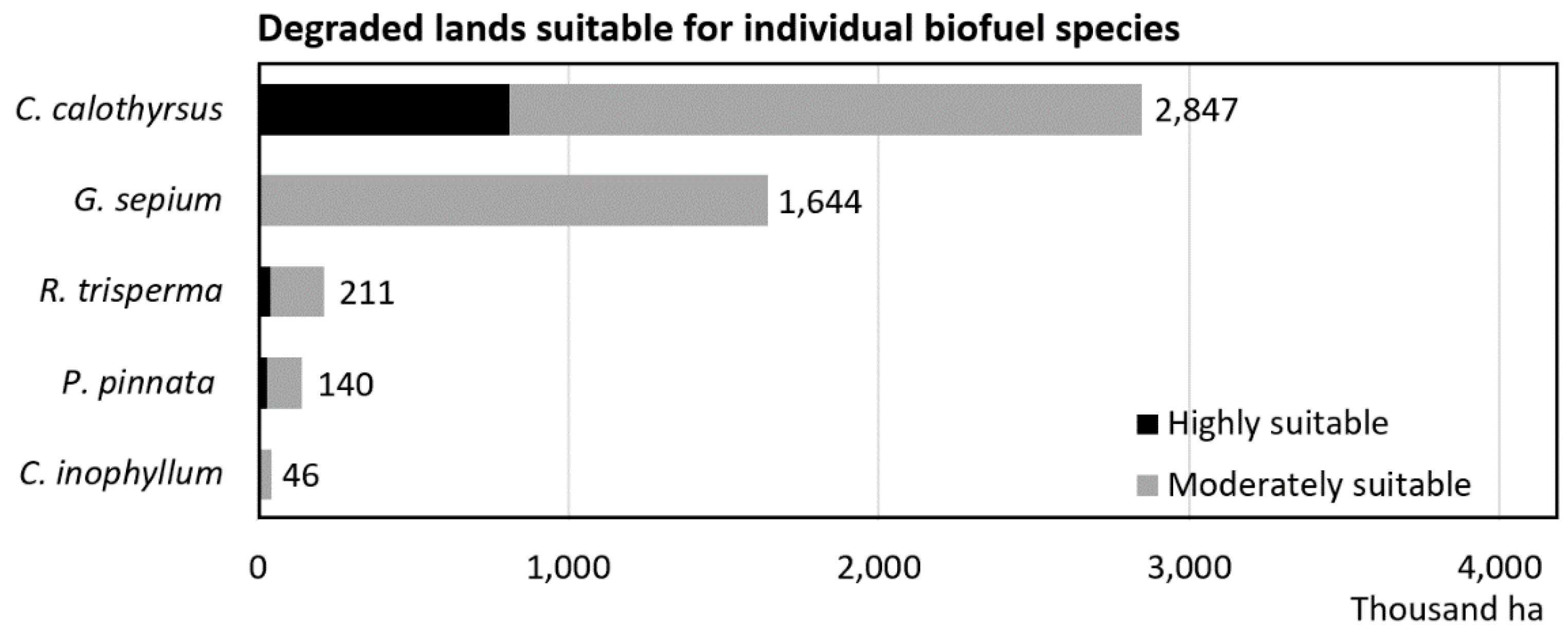

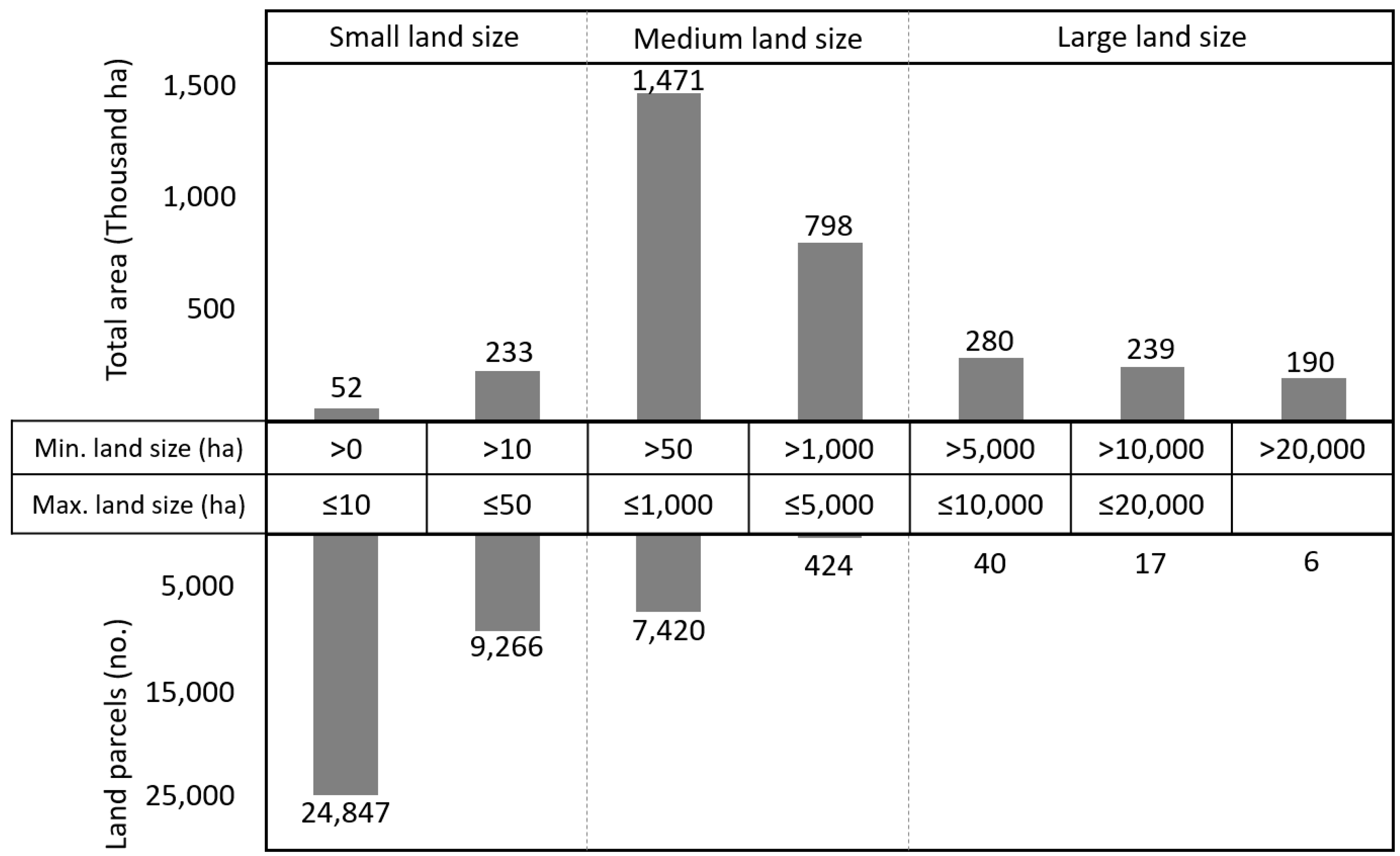
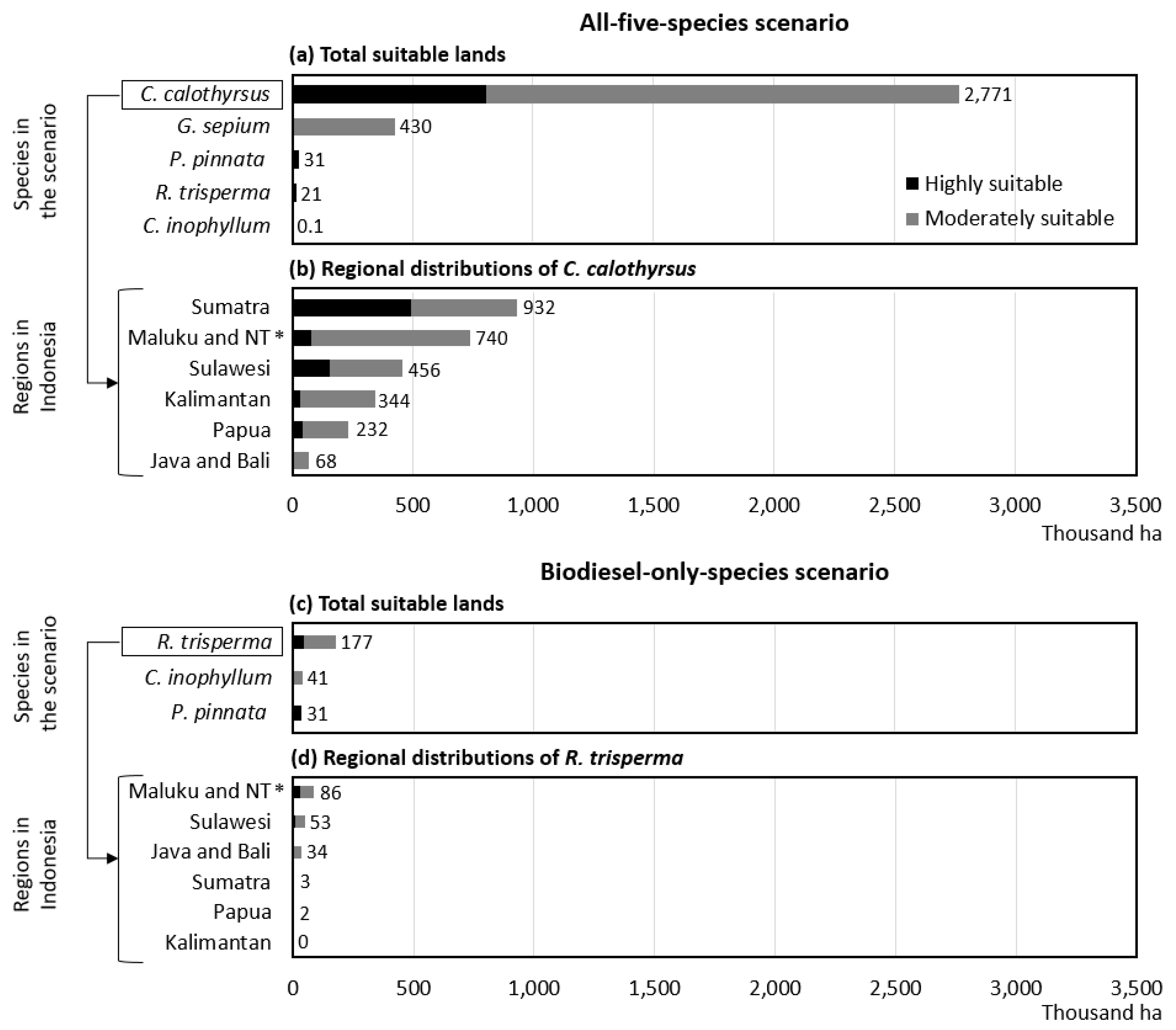
| Species | Indonesian Name | Tolerable Condition | Local Use | Biomass Type | Food Consumption |
|---|---|---|---|---|---|
| C. inophyllum1 (Biodiesel) | Nyamplung | Salinity Sandy soil | Wood, medicine, and cosmetics | Seed oil | No |
| R. trisperma2 (Biodiesel) | Kemiri sunan | Sloping land | Pesticide and fertilizer | Seed oil | No |
| P. pinnata3 (Biodiesel) | Malapari | Salinity Water logging Drought | Wood, firewood, and medicine | Seed oil | No |
| C. calothyrsus4 (Biomass) | Kaliandra | Drought Acidic soil Sandy soil | Firewood and animal feedstock | Wood | No |
| G. sepium5 (Biomass) | Gamal | Acidic soil | Firewood, animal feedstock, medicine | Wood or seed oil | No |
| Study | Land Condition | Land Location | Area (Mha) | Biofuel Species | Potential Energy Production | Method |
|---|---|---|---|---|---|---|
| [54] | Unproductive forestlands degraded by logging, cultivation, and other activities | Indonesia | 27 | Palm oil | NA | Information from Department of Agriculture |
| [55] | Degraded lands that support sustainable palm oil production environmentally, economically, legally, and socially | West and Central Kalimantan | 7 | Palm oil | NA | Spatial analysis and field survey |
| [9] | Administratively available lands; coherence to biofuel, agriculture, climate, and forestry policies | Indonesia | 21 | Palm oil | NA | Policy analysis |
| [56] | Degraded lands that have poor climate, poor physical characteristics, or difficult cultivation | Indonesia as a part of APEC countries | 3.7 | Biomass production potential | 15 million tons of biomass per year/6 cubic hectometers of ethanol | Spatial analysis |
| [57] | Lands that have degraded soils | Indonesia as part of a global study | 30 | Grasses and woody crops | About 7000 PJ year−1 from grasses/about 5000 PJ year−1 from woody crops | Spatial analysis |
| [6] | Lands with suitable climates and ecological conditions | West Java | 0.9 | R. trisperma | NA | Spatial analysis |
| [5] | Degraded lands that exclude high-carbon lands, lands with concessions and new permits, and lands with high slope and altitude | Indonesia | 24 | Bioethanol crops | NA | Spatial analysis |
| C. inophyllum | R. trisperma | P. pinnata | ||||
| Attributes 1 | Highly Suitable | Moderately Suitable | Highly Suitable | Moderately Suitable | Highly Suitable | Moderately Suitable |
| Annual rainfall (mm) | 2000–4000 | 750–2000 | 1500–2500 3 | 700–2500 | 500–2000 | 400–500 |
| 4000–5000 | 2000–2500 | |||||
| Temperature (°C) | 28–35 | 10–28 | 24–30 | 18–30 3 | 16–40 | 10–16 |
| 35–42 | 40–50 | |||||
| Altitude (m) | 0–200 | 0–200 | 0–700 | 0–700 | 0–1200 | 0–1200 |
| Soil pH | 5.5–7.0 | 5.0–5.5 | 5.4–7.1 | >7.1 | 6.5–8.5 | 6.0–6.5 |
| 7.0–8.0 | 8.5–9.0 | |||||
| Soil depth (cm) | 20–50 | 20–50 | >100 | 50–100 | >150 | 50–150 |
| Soil slope (%) | <30 2 | <30 | <8 4 | 8–25 | <20 5 | <20 |
| C. calothyrsus | G. sepium | |||||
| Attributes | Highly Suitable | Moderately Suitable | Highly Suitable | Moderately Suitable | ||
| Annual rainfall (mm) | 2000–4000 | 750–2000 | 1200–2300 | 600–1200 | ||
| 4000–5000 | 2300–3500 | |||||
| Temperature (°C) | 22–30 | 18–22 | 15–30 | 12–15 | ||
| 30–34 | 30–44 | |||||
| Altitude (m) | 0–1800 | 0–1800 | 0–1600 | 0–1600 | ||
| Soil pH | 5.0–6.0 | 4.5–5.0 | 5.5–6.2 | 4.5–5.5 | ||
| 6.0–7.5 | 6.2–8.0 | |||||
| Soil depth (cm) | 50–150 | 20–50 | >150 | 50–150 | ||
| Soil slope (%) | <80 6 | <80 | <40 7 | <40 | ||
| C. inophyllum | R. trisperma | P. pinnata | ||||
| Attributes | Highly Suitable | Moderately Suitable | Highly Suitable | Moderately Suitable | Highly Suitable | Moderately Suitable |
| Biofuel type | Biodiesel | Biodiesel | Biodiesel | Biodiesel | Biodiesel | Biodiesel |
| Biodiesel yield (kg/ha/year) | 10,400 1 | 2773 | 8000 3 | 6000 | 1800 5 | 180 |
| Energy productivity (TJ/ha/year) | 0.417 | 0.111 | 0.040 | 0.010 | 0.064 | 0.006 |
| Caloric value (MJ/kg) | 40.10 2 | 40.10 | 35.50 4 | 35.50 | 35.56 6 | 35.56 |
| C. calothyrsus | G. sepium | |||||
| Attributes | Highly Suitable | Moderately Suitable | Highly Suitable | Highly Suitable | ||
| Biofuel type | Biomass | Biomass | Biomass | Biomass | ||
| Biomass yield (kg/ha/year) | 40,000 7 | 15,000 | 5300 9 | 2000 | ||
| Energy productivity (TJ/ha/year) | 0.704 | 0.264 | 0.089 | 0.034 | ||
| Caloric value (MJ/kg) | 17.60 8 | 17.60 | 16.85 8 | 16.85 | ||
| Species | Type | Highly Suitable Lands | Moderately Suitable Lands | Total |
|---|---|---|---|---|
| All-five-species scenario | 1,104,598 | |||
| (a) Biomass total | 568,867 | 532,921 | 1,101,787 | |
| C. calothyrsus | Biomass | 568,494 | 518,443 | 1,086,937 |
| G. sepium | Biomass | 373 | 14,478 | 14,851 |
| (b) Biodiesel total | 2796 | 15 | 2811 | |
| R. trisperma | Biodiesel | 1956 | 0 | 1956 |
| P. pinnata | Biodiesel | 841 | 0 | 841 |
| C. inophyllum | Biodiesel | 0 | 15 | 15 |
| Biodiesel-only-species scenario | 9661 | |||
| (a) Biodiesel total | 3852 | 5809 | 9661 | |
| C. inophyllum | Biodiesel | 229 | 4448 | 4678 |
| R. trisperma | Biodiesel | 1655 | 1361 | 3016 |
| P. pinnata | Biodiesel | 1967 | 0 | 1967 |
© 2018 by the authors. Licensee MDPI, Basel, Switzerland. This article is an open access article distributed under the terms and conditions of the Creative Commons Attribution (CC BY) license (http://creativecommons.org/licenses/by/4.0/).
Share and Cite
Jaung, W.; Wiraguna, E.; Okarda, B.; Artati, Y.; Goh, C.S.; Syahru, R.; Leksono, B.; Prasetyo, L.B.; Lee, S.M.; Baral, H. Spatial Assessment of Degraded Lands for Biofuel Production in Indonesia. Sustainability 2018, 10, 4595. https://doi.org/10.3390/su10124595
Jaung W, Wiraguna E, Okarda B, Artati Y, Goh CS, Syahru R, Leksono B, Prasetyo LB, Lee SM, Baral H. Spatial Assessment of Degraded Lands for Biofuel Production in Indonesia. Sustainability. 2018; 10(12):4595. https://doi.org/10.3390/su10124595
Chicago/Turabian StyleJaung, Wanggi, Edi Wiraguna, Beni Okarda, Yustina Artati, Chun Sheng Goh, Ramdhoni Syahru, Budi Leksono, Lilik Budi Prasetyo, Soo Min Lee, and Himlal Baral. 2018. "Spatial Assessment of Degraded Lands for Biofuel Production in Indonesia" Sustainability 10, no. 12: 4595. https://doi.org/10.3390/su10124595
APA StyleJaung, W., Wiraguna, E., Okarda, B., Artati, Y., Goh, C. S., Syahru, R., Leksono, B., Prasetyo, L. B., Lee, S. M., & Baral, H. (2018). Spatial Assessment of Degraded Lands for Biofuel Production in Indonesia. Sustainability, 10(12), 4595. https://doi.org/10.3390/su10124595







